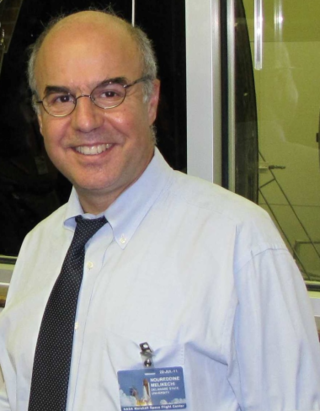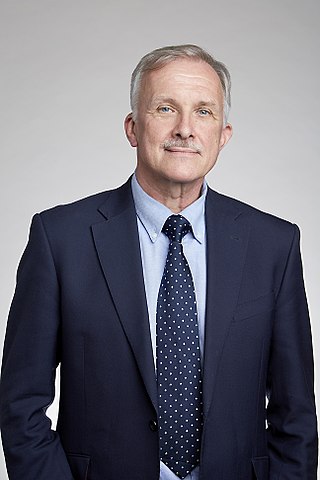Related Research Articles
Chen Yung-Jui received his BS in Physics from National Tsing Hua University in 1969 and Ph.D. in Physics at the University of Pennsylvania (1976). After a brief postdoctoral period at Penn, he joined the Advanced Microelectronic Laboratory at McDonnell Douglas Astronautics Co. in 1977. From 1980 to 1987, Dr. Chen conducted fiber optical communications related research at GTE Laboratories. During the ten years in industry, he worked on MOS/MNOS VLSI technology, wafer scale integration, Ultra-fast optical spectroscopy, nonlinear optics of semiconductors and organic polymers, integrated optics and optoelectronic devices. In 1987, he moved to academe and became one of the founding faculty members of the Department of Electrical Engineering at University of Maryland, Baltimore County.
Jean-Luc Brédas is an American chemist, working at the University of Arizona. He was born in Fraire, Belgium, on 23 May 1954.
Larry Dalton is an American chemist best known for his work in polymeric nonlinear electro-optics.

Francisco Javier "Frank" Duarte is a laser physicist and author/editor of several books on tunable lasers.
Elsa M. Garmire, Elsa Meints Garmire, was born in Buffalo, New York, on November 9, 1939. She is the Sydney E. Junkins Professor of Engineering at Dartmouth College, where she has served as Dean of Thayer School of Engineering. Elected to the American Academy of Arts and Sciences, the National Academy of Engineers, and the National Academy of Inventors, she helped pioneer laser technology and is an expert in nonlinear optics. She has patented devices to enhance optical communications including lasers, waveguides, and detectors.

Robert Louis Byer is a physicist. He was president of the Optical Society of America in 1994 and of the American Physical Society in 2012.
The Journal of the Optical Society of America is a peer-reviewed scientific journal of optics, published by Optica. It was established in 1917 and in 1984 was split into two parts, A and B.
Eric Van Stryland was president of the Optical Society of America in 2005.

Anthony Michael Johnson is an American experimental physicist, a professor of physics, and a professor of computer science and electrical engineering at the University of Maryland, Baltimore County (UMBC). He is the Director of the Center for Advanced Studies in Photonics Research (CASPR), also situated on campus at UMBC. Since his election to the 2002 term as president of the Optical Society, formerly the Optical Society of America, Johnson has the distinction of being the first and only African-American president to date. Johnson's research interests include the ultrafast photophysics and nonlinear optical properties of bulk, nanostructured, and quantum well semiconductor structures, ultrashort pulse propagation in fibers and high-speed lightwave systems. His research has helped to better understand processes that occur in ultrafast time frames of 1 quadrillionth of a second. Ultrashort pulses of light have been used to address technical and logistical challenges in medicine, telecommunications, homeland security, and have many other applications that enhance contemporary life.
Girish S. Agarwal, Fellow of the Royal Society UK, is a theoretical physicist. He is currently at the Texas A & M University with affiliations to the Departments of Biological and Agricultural Engineering, Physics and Astronomy, and the Institute for Quantum Science and Engineering. Earlier he worked as Noble Foundation Chair and the Regents Professor at the Oklahoma State University. He is a recognized leader in the field of quantum optics and also has made major contributions to the fields of nonlinear optics, nanophotonics and plasmonics. In 2013 he published the textbook "Quantum Optics", covering a wide range of recent developments in the field, which has been well received by the community.

Robert William Boyd is an American physicist noted for his work in optical physics and especially in nonlinear optics. He is currently the Canada Excellence Research Chair Laureate in Quantum Nonlinear Optics based at the University of Ottawa, Professor of Physics cross-appointed to the School of Electrical Engineering and Computer Science at the University of Ottawa, and Professor of Optics and Professor of Physics at the University of Rochester.
Matthew R. Linford is an associate professor at Brigham Young University, Department of Chemistry and Biochemistry since September 2006. His lab is devoted towards synthesizing hydrophobic surfaces, diamond stationary phases for liquid chromatography and microfabricated TLC plates.

Organic photonics includes the generation, emission, transmission, modulation, signal processing, switching, amplification, and detection/sensing of light, using organic optical materials.

Noureddine Melikechi, D.Phil is an Algerian atomic, molecular, and optical physicist, educator and inventor. He is the author of more than 125 peer-reviewed publications, three book chapters and 15 patents. Melikechi is a member of the Mars Science Laboratory, NASA’s largest Mars exploration effort to date.

(James) Roy Taylor is Professor of Ultrafast Physics and Technology at Imperial College London.

Andrea Martin Armani is the Ray Irani Chair in Engineering and Materials Science and professor of chemical engineering and materials science at the USC Viterbi School of Engineering. She was awarded the 2010 Presidential Early Career Award for Scientists and Engineers from Barack Obama and is a World Economic Forum Young Global Leader.

Jacqueline Manina Cole is the Head of the Molecular Engineering group in the Cavendish Laboratory at the University of Cambridge. Her research considers the design of functional materials for optoelectronic applications.
David Nathan Beratan is an American chemist and physicist, the R.J. Reynolds Professor of Chemistry at Duke University. He has secondary appointments in the departments of Physics and Biochemistry. He is the director of the Center for Synthesizing Quantum Coherence, a NSF Phase I Center for Chemical Innovation.

Debabrata Goswami FInstP FRSC, is an Indian chemist and the Prof. S. Sampath Chair Professor of Chemistry, at the Indian Institute of Technology Kanpur. He is also a professor of The Department of Chemistry and The Center for Lasers & Photonics at the same Institute. Goswami is an associate editor of the open-access journal Science Advances. He is also an Academic Editor for PLOS One and PeerJ Chemistry. He has contributed to the theory of Quantum Computing as well as nonlinear optical spectroscopy. His work is documented in more than 200 research publications. He is an elected Fellow of the Royal Society of Chemistry, Fellow of the Institute of Physics, the SPIE, and The Optical Society. He is also a Senior Member of the IEEE, has been awarded a Swarnajayanti Fellowship for Chemical Sciences, and has held a Wellcome Trust Senior Research Fellowship. He is the third Indian to be awarded the International Commission for Optics Galileo Galilei Medal for excellence in optics.
John Ballato is an American materials scientist, entrepreneur, and academic. He holds the J. E. Sirrine Endowed Chair of Optical Fiber and is a professor of materials science and engineering, electrical and computer engineering, as well as physics and astronomy at Clemson University. He has received many international recognitions for his research on optical and optoelectronic materials, particularly as relates to optical fiber.
References
- ↑ "The Lew Allen Award for Excellence Recipients". JPL. Retrieved 5 October 2020.
- ↑ "Profile Georgia Tech Chemistry & Biochemistry". www.chemistry.gatech.edu. Retrieved 2017-08-09.
- 1 2 3 "Introducing Seth Marder, Editorial Board Chair of Materials Horizons". Royal Society of Chemistry. Retrieved 6 October 2020.
- ↑ "Seth Marder". 13 August 2020.
- ↑ "Seth Marder". 16 February 2021.
- ↑ "Marder School of Materials Science and Engineering". www.mse.gatech.edu. Retrieved 2017-08-09.